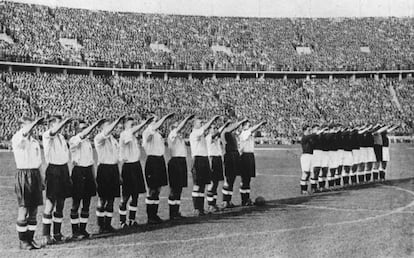When the Nazis used soccer as a weapon of mass manipulation
Major sporting events, such as the 1936 Games, served the Reich as loudspeakers for National Socialism, as documented by an exhibition on the grounds of the Olympic Stadium in Berlin


Adolf Hitler extolled the virtues of sport, especially its effect among young people. “What wonderful bodies you can see today!” he remarked on one occasion, after gazing at a picture of a swimmer. But when it came to physical exercise, he could not be said to lead by example. “He refused to practice any sport,” wrote Albert Speer, the Führer’s favorite architect, confidant, and Reich Armaments Minister, in his memoirs: “Nor did he ever mention having done so in his youth.”
The Nazis, however, were interested in sport as a weapon of mass manipulation. Major sporting events, such as soccer matches, were the ideal occasion to inoculate the crowds with fascist ideology. The exhibition Sport. Masse. Macht. Fußball im Nationalsozialismus (Sport. Masses. Power. Football during National Socialism), which is on display at the Berlin Sports Museum, in a building built by the Nazis inside the Olympic complex whose stadium will host the European Championship final at a time when the rise of the extreme right — the far-right party AfD was the second most-voted political force in the European elections of June 9 — is concerning the entire continent.
“Soccer was already a popular sport in the 1920s. Every weekend, thousands of people of different ages and social classes gathered in the stadiums to watch matches. For the Nazis, such mass spectacles were an ideal way to seek the support of a majority they did not yet have,” explains historian Julian Rieck, curator of the exhibition. “In soccer specifically, an atmosphere of unity was created among spectators that allowed for the mass practice of gestures and rituals such as the Nazi salute.”
The exhibition shows how sport was used to create a common identity and as a propaganda tool abroad. Using a wealth of documentation, historical photographs and newspaper clippings, the exhibition traces the fate of dozens of Jewish soccer clubs during the rise of National Socialism and reveals a little-known aspect of the Nazi concentration camps: how soccer was also played in them. And how some prisoners managed to save their own lives because of it.
The incredible story of Saturnino Navazo, from Burgos in Spain, stands out among the many examples of the lives of athletes cut short by Nazism. Navazo had been a second division player before enlisting in the Republican army during the Spanish Civil War. Following the Nationalist victory in 1939, he escaped across the Pyrenees to France, where he was interned in the Argelès-sur-Mer camp until the French government decided to send Spanish Republicans to work for the Nazi arms industry.
In Mauthausen, he ended up being the captain of the Spanish soccer team and, probably thanks to that, he saved himself and an eight-year-old Jewish orphan, Siegfried Meir, whom he passed off as his son when the camp was liberated. “Stories like that of a Spaniard who arrives at a German concentration camp and saves a Jewish boy from Frankfurt make it clear that Nazism was born in Germany but affected all of Europe. With the exhibition, we want to connect these stories and show the public coming to the European Championship that this is ultimately a European story,” says Rieck.
One of the most notorious cases of propaganda through sport is the game between the English and German national soccer teams held on December 4, 1935 in London, at White Hart Lane, the former stadium of Tottenham Hotspur, a team with a notable Jewish fan base. For the occasion, the Nazi government organized for 10,000 fans to travel to the event and do the Nazi salute during the match.
The London newspaper Jewish Chronicle analyzed the intention of the event as follows: “There is little doubt that the ulterior purpose is to present to the world the spectacle of an Anglo-Nazi fraternization, to silence protests against Nazi tyranny [...] and to give the impression that this country has reconciled itself to Nazism and all that that implies.” As soon as the game became common knowledge, it unleashed a wave of protests by anti-fascist groups. Rallies were organized and posters were circulated calling for the event to be called off. One of these can be seen at the exhibition: “Propaganda for war, propaganda for racial hatred and savagery is the purpose that Hitler sees fulfilled with this proposed visit.”
But the biggest case of Nazi politicization through sport was the staging of the Berlin Olympics in 1936, for which the site that today houses the exhibition was built. “The sports festival became a propaganda spectacle,” the curator points out. The regime was thus able to conceal the restrictions on freedom of the press, the persecution of Jews and Roma, and the construction of the Sachsenhausen concentration camp just a few miles from the stadium, which went unnoticed by many Germans and visitors.
Leading and independent intellectuals warned of ideological manipulation at the time. “I find the Olympic Games odious because they are not a matter of sport, but an entirely political enterprise,” wrote the noted philologist Victor Klemperer, author of The Language of the Third Reich, an influential analysis of the perversion of language under the Nazi regime.
The Reich commissioned the regime’s top filmmaker, Leni Riefenstahl, to shoot the documentary Olympia (1938), which was intended to extol the supposed athletic virtues of the Aryan race. However, a young Black prodigy from the American Deep South shattered the dream of Aryan athletic supremacy at the 1936 Games: 22-year-old Jesse Owens won four gold medals in the 100- and 200-meter dash, 400-meter relay and long jump, and set two Olympic records.
The Nazis, however, did not give up and in their national community (Volksgemeinschaft) there was only room for Aryan purity. The Aryanization of sport, as in the rest of society, led first to the exclusion and then to the arrest of Jews and Roma. In 1938, Jews were forbidden by law to participate in sporting activities. With the invasion of Poland by the Third Reich and the advance of World War II, the Nazis destroyed Jewish soccer clubs throughout occupied Europe. The exhibition displays reproductions of the jerseys of 11 clubs pulled apart by the Nazis and allows visitors to read examples of the so-called Aryan paragraphs, texts added to the clubs’ statutes that vetoed “non-Aryan” members.
During the war, athletes also experienced stories of heroism and misery, which the exhibition briefly recounts. One example is Otto Harder (1892-1956), a two-time German league champion with Hamburg and international with the German national team, who became the commandant of a concentration camp where hundreds of people died. Visitors can also watch and listen to five current athletes presenting video biographies of five other elite athletes (Lili Henoch, Heinz Kerz, Béla Guttmann, Eddy Hamel and Julius Hirsch) whose careers and lives were shattered by the Nazis. Their stories represent millions of victims across Europe.
The exhibition also follows the relationship between politics and sport during the period of divided Germany and after reunification, up to the present day, when it provides an enlightening statistic: almost 20% of the seven million members of the German Football Association are immigrants or children of immigrants, a fact that shows a multicultural Germany integrating through sport.
Sign up for our weekly newsletter to get more English-language news coverage from EL PAÍS USA Edition
Tu suscripción se está usando en otro dispositivo
¿Quieres añadir otro usuario a tu suscripción?
Si continúas leyendo en este dispositivo, no se podrá leer en el otro.
FlechaTu suscripción se está usando en otro dispositivo y solo puedes acceder a EL PAÍS desde un dispositivo a la vez.
Si quieres compartir tu cuenta, cambia tu suscripción a la modalidad Premium, así podrás añadir otro usuario. Cada uno accederá con su propia cuenta de email, lo que os permitirá personalizar vuestra experiencia en EL PAÍS.
¿Tienes una suscripción de empresa? Accede aquí para contratar más cuentas.
En el caso de no saber quién está usando tu cuenta, te recomendamos cambiar tu contraseña aquí.
Si decides continuar compartiendo tu cuenta, este mensaje se mostrará en tu dispositivo y en el de la otra persona que está usando tu cuenta de forma indefinida, afectando a tu experiencia de lectura. Puedes consultar aquí los términos y condiciones de la suscripción digital.
More information
Archived In
Últimas noticias
Most viewed
- Sinaloa Cartel war is taking its toll on Los Chapitos
- Oona Chaplin: ‘I told James Cameron that I was living in a treehouse and starting a permaculture project with a friend’
- Reinhard Genzel, Nobel laureate in physics: ‘One-minute videos will never give you the truth’
- Why the price of coffee has skyrocketed: from Brazilian plantations to specialty coffee houses
- Silver prices are going crazy: This is what’s fueling the rally










































